Uchenna Cecilia Dike
Where do you live: Montreal, Quebec, Canada
Your education: Nursing
Describe your art in three words: Intuitive, Transformative, Textural
Instagram
Your artistic journey is deeply intertwined with your studies in nursing. How do you feel that your academic background influences your approach to art, especially when it comes to recognizing patterns in both anatomy and abstract composition?
As a nurse in the making, I’ve learned to recognize patterns—whether in clinical rotations or theory—by connecting symptoms to underlying pathologies, linking function and form, and understanding the cascading consequences that arise from different clinical profiles. Nursing is a profession where understanding the why behind a physical or mental presentation can make the difference between life and death. That drive to understand the deeper mechanisms rather than just executing a task is central to how I approach both nursing and art.
This analytical precision translates directly into my abstract art. Just as sharp clinical observation helps uncover hidden patterns in the body, the sharp intersecting lines in my compositions form a matrix where emotional states emerge. What may seem like isolated shapes or lines take on meaning when they converge—forming a visual language tied to emotion, colour, and expression. Through both art and nursing, I explore the underlying structure of what’s seen and unseen, transforming fragmented elements into a cohesive whole.
Your work explores emotional states that spark transformation. Can you share more about how these emotions manifest in your artwork and the process through which they evolve on the canvas?
The emotions in my work manifest through the interplay between shapes, colours, and textures. A consistent element across my pieces is the presence of a white or lighter border that frames the colourful, dimensional composition within it. This contrast between the formless and the formed creates a sense of structure and amplifies the vibrancy of the work. The border acts almost like a threshold—separating the contained emotional universe from the surrounding emptiness, which makes the artwork feel more alive and visually striking.
The emotional impact also emerges through the glow of the composition itself. My work invites calm and patient contemplation; the more you engage with it, the more it reveals. Emotion evolves on the canvas as layers of texture and color are added, deepening the sense of depth and complexity. Each added layer transforms the piece, making it feel like a glimpse into a separate, contained universe—a window into an emotional landscape that takes shape and meaning over time.
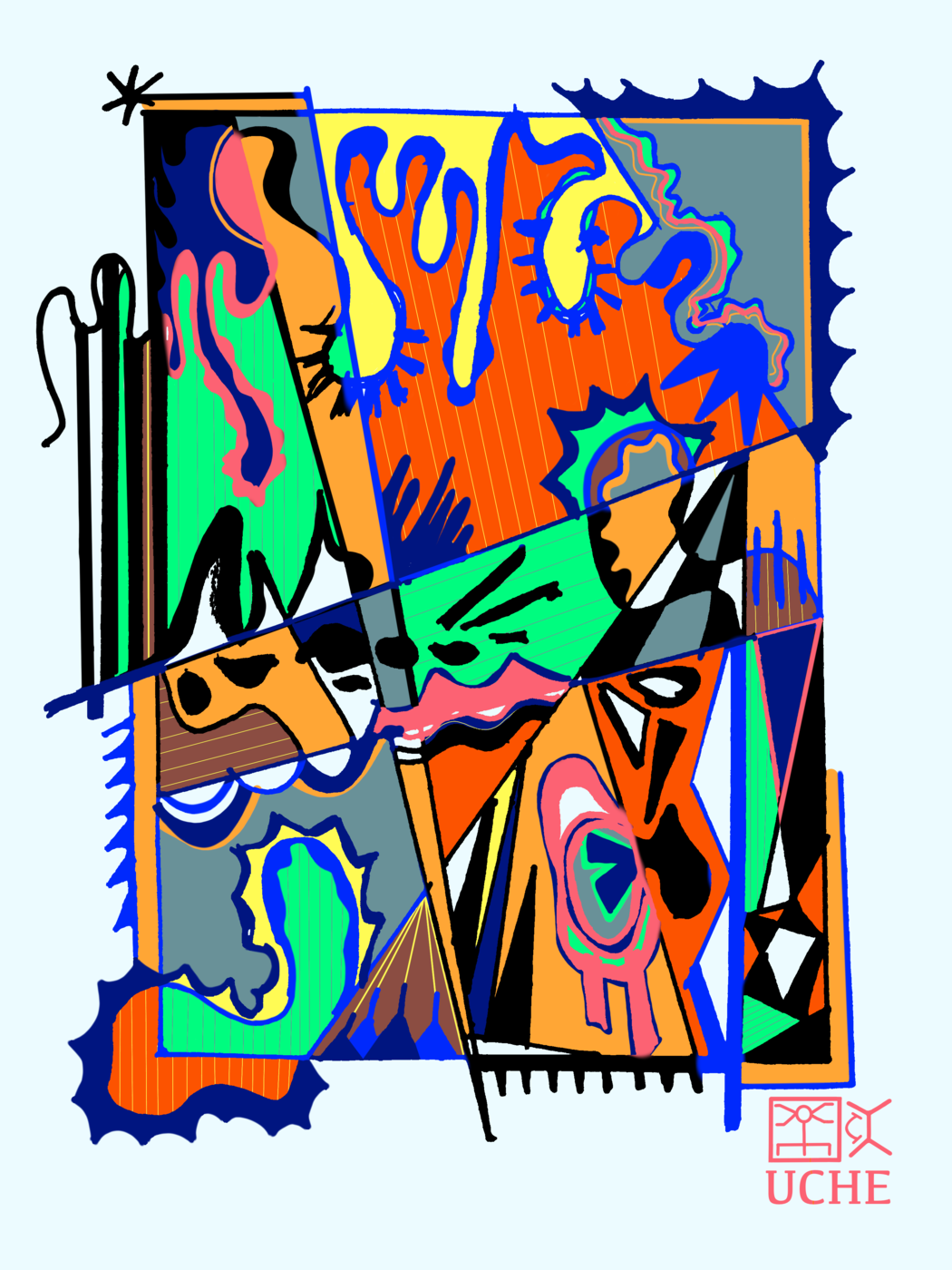 Uchenna Cecilia Dike | Excited Frenzy | 2024
Uchenna Cecilia Dike | Excited Frenzy | 2024
The concept of Afrocentric patterns plays a significant role in your work. Could you tell us more about how your Nigerian Igbo heritage influences the shapes, textures, and overall themes of your art?
My Nigerian Igbo heritage doesn’t yet fully influence the themes of my work—though I do plan to explore that more intentionally in the future. However, it undeniably shapes the forms and textures within my art. I’ve always been enthralled by Ankara fabrics—the traditional textiles with their bold patterns and vivid colour combinations. There’s something captivating about how different shapes and forms come together to create a striking visual relationship. Each piece of Ankara fabric has its own personality, and I have a growing collection at home that reflects this diversity.
I think this influence shows up unconsciously in my work. Just as Ankara fabrics often feature the same motif in different colour variations—transforming the overall impact—I approach my abstract matrix in a similar way. The sharp lines that define my compositions form a structured base, but by changing the colours or altering the texture, I create entirely new emotional landscapes within that same framework.
When it comes to themes, my work tends to address more universal emotional experiences—ideas that can resonate across cultures, religions, and socioeconomic backgrounds. While the patterns and textures reflect my Igbo heritage, the emotional core of my work speaks to our shared experience on Earth, making it accessible and meaningful to people from different walks of life.
How do you view the intersection of art and science in your life? Does it shape your perception of the world and, in turn, your creative process?
The intersection of art and science in my life has been a relationship I’ve had to refine over time. Being in an accelerated nursing program, the demanding schedule initially made it difficult to balance both sides. When I wasn’t creating, I often felt unfulfilled and creatively unproductive. Interestingly, even when focusing on science, I would naturally approach problem-solving creatively—designing colourful, artistic study guides and tools that my friends found helpful. That’s when I realized that creativity wasn’t limited to art—it was embedded in how I process and understand the world. Once I embraced that creative lens in both fields, the connection between art and science became more defined and enriching.
This intersection shapes how I see the world. I notice symmetry, patterns, and the inherent creativity in everyday life—even in the smallest, most mundane activities. It’s made me realize that creativity is a fundamental reality; even those who don’t consider themselves artists are constantly creating in their own way.
Art and science also intersect directly in my creative process. Though my approach to composition is intuitive, there’s still a mathematical foundation beneath it. I’m aware of the ratios, the balance of size and proportion, and how adjusting those elements affects the overall structure and emotional impact of the piece. That subtle balance between intuition and precision reflects the deeper connection between artistic and scientific thinking in my life.
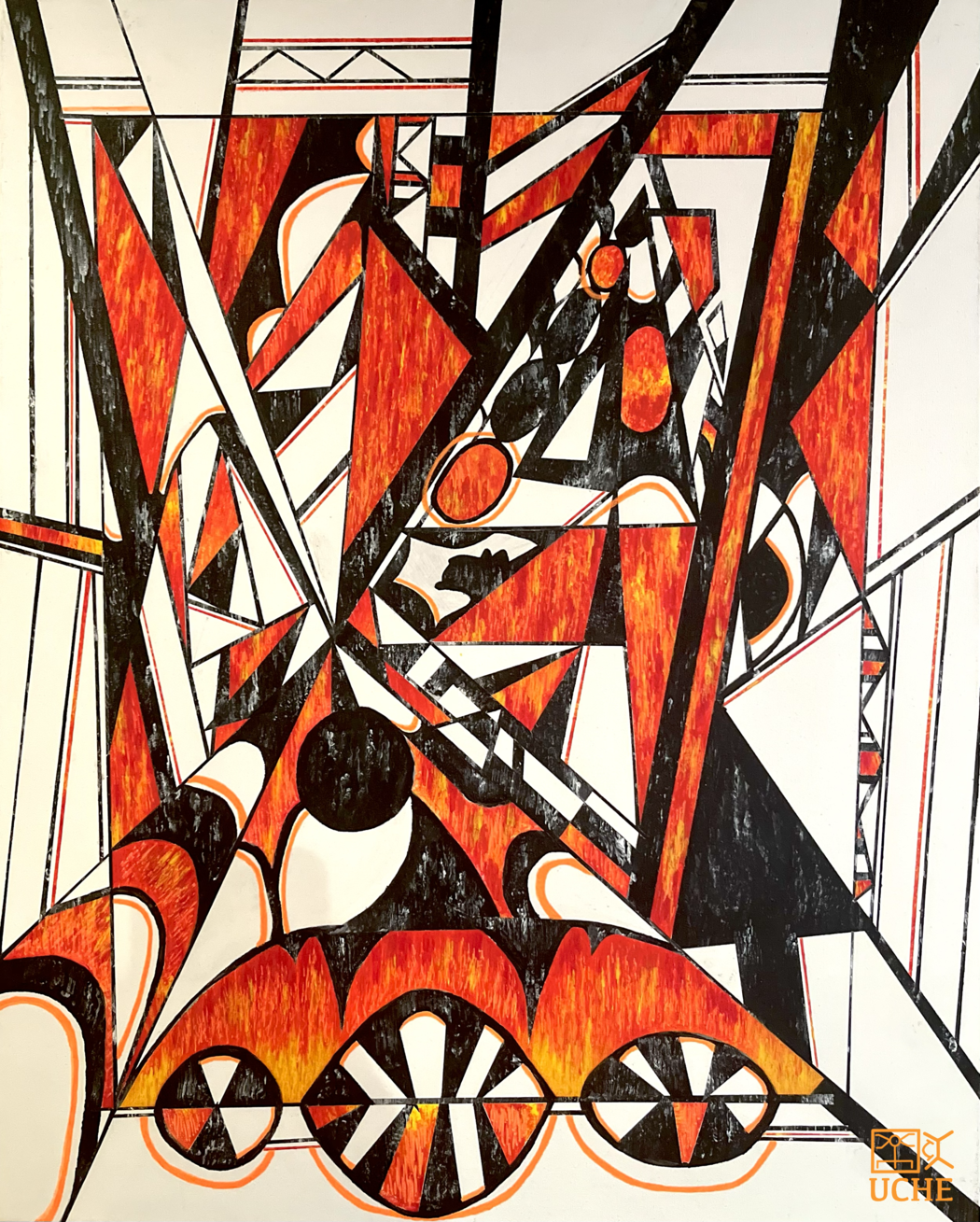 Uchenna Cecilia Dike | In Disarray | 2020-2025
Uchenna Cecilia Dike | In Disarray | 2020-2025
You mention that your process is intuitive, often not following a strict plan. Can you describe a specific instance where this intuitive approach led to an unexpected or surprising outcome in your work?
In my triptych Unrest—which includes In Disarray, Insurrection, and A King is Dead Today— my process was deeply intuitive. It began as a simple sketch with a black pen and a ruler in my sketchbook, with no clear direction at first. I didn’t fully understand where it was leading until much later.
During the COVID lockdown, I remember watching American news when the story of Ahmaud Arbery’s killing broke. He was a young Black man, shot while jogging in Georgia by three men. That period was already marked by global uncertainty—a health crisis, isolation, and deep social division—and this tragedy was another devastating blow. I remember crying for him and his family, overwhelmed by the injustice and senselessness of his death. That was in February 2020.
Months later, in July of that same year, I sketched what would eventually become the third piece of the triptych. It was only much later that I realized the connection—the piece was an emotional response to Ahmaud Arbery’s killing, even though I hadn’t set out to create it with that in mind. The final painting, completed on a wood panel in acrylic, reflects that moment of injustice. Symbols within the piece reference that tragedy, but the message extends beyond it—speaking to the broader reality of unjust and unlawful killings of young Black men, not only in the U.S. but also in Canada and globally.
That’s why I say most of my pieces, if not all, represent emotional states that transcend specific events. They reflect universal experiences that can be applied to different backgrounds, cultures, and historical moments.
In your triptych Unrest, you address themes of global uncertainty and social issues. How do you hope your artwork communicates these themes to the viewer, and what kind of emotional response do you hope to evoke?
Unrest is a reflection of the turbulence we’re experiencing—both collectively and individually. The triptych captures the chaos, the disconnection, and the underlying tension of a world that feels on the brink of transformation. Each panel speaks to a different facet of this unrest: one delves into personal strife, the inner turmoil of identity and emotional conflict; another explores the outward manifestations—war, politics, and societal discord; and the third brings a sense of hope, hinting at the possibility of change through introspection and collective action, although pain and frustration are felt.
Through this work, I aim to stir a complex emotional response from the viewer—one that evokes not only a sense of urgency but also reflection. I want the viewer to experience a raw, almost visceral reaction to the chaotic textures, distorted shapes, and shifting patterns that make up each scene. I use colour, fragmentation, and layered forms to reflect the emotional impact of social issues and personal crises, guiding the viewer through a narrative of discomfort and potential resolution.
Ultimately, I hope Unrest does more than communicate a message—it is an invitation to pause, to confront, and to question. I want viewers to feel the weight of the uncertainty we live in, but also to experience a sense of empowerment, as if they too are part of the change that must come. It’s about engaging with that unrest, not just as an observer, but as an active participant in its unfolding.
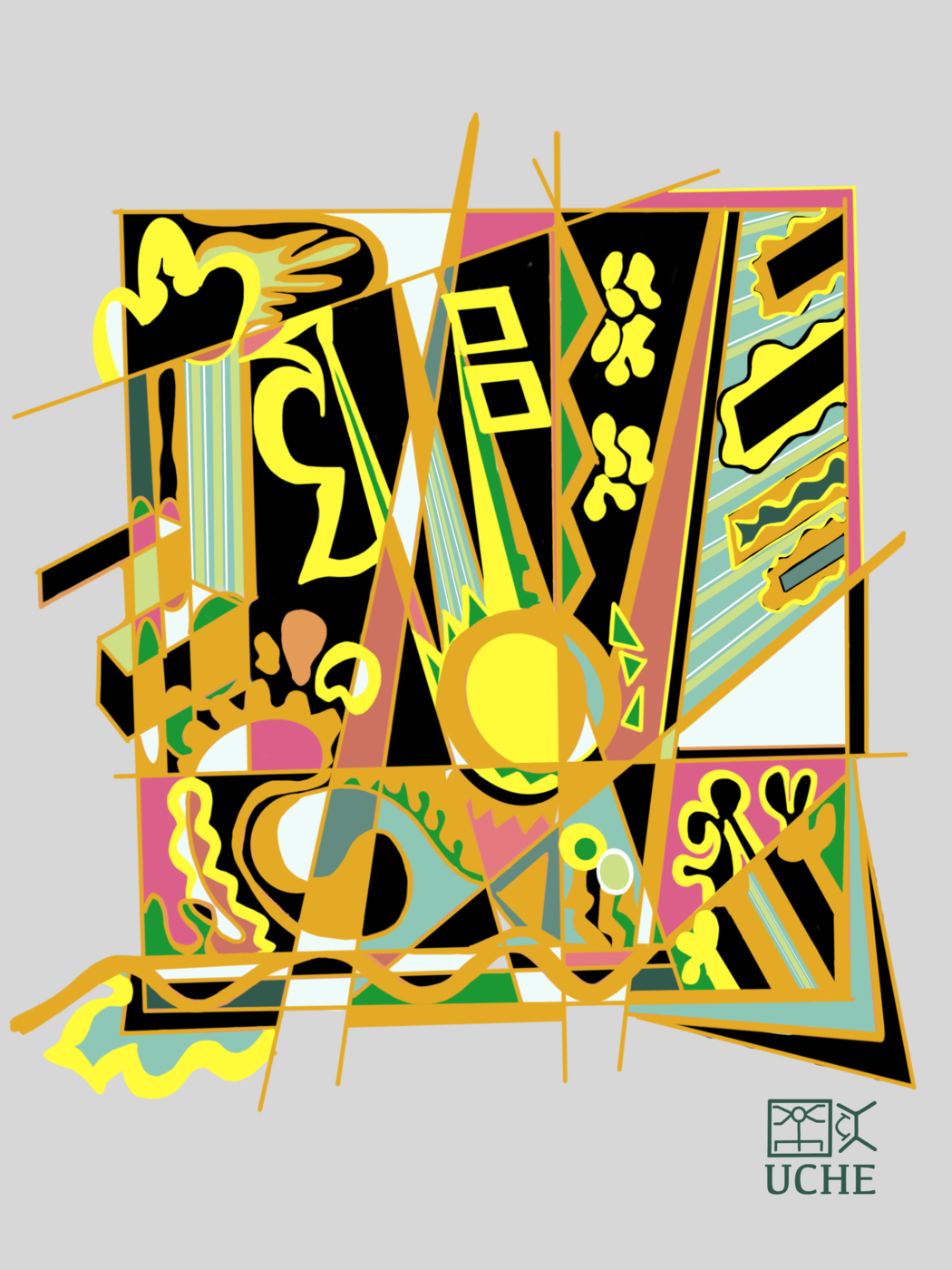 Uchenna Cecilia Dike| My Ray of Sunshine | 2022-2024
Uchenna Cecilia Dike| My Ray of Sunshine | 2022-2024
Texture is an essential element of your work. Could you talk about how you experiment with texture, both in traditional media and digitally, and what kind of impact you want it to have on the viewer’s experience?
Texture in my work is a reflection of the raw emotions and experiences I explore. It’s an integral part of my artistic language, allowing me to add layers of meaning and depth. In traditional media, such as acrylic on canvas, I experiment with varying materials—gouache, Posca pens, and even fabric eventually—to build a tactile surface that almost invites the viewer to physically connect with the work. These textures are not just visual but physical, creating a sense of movement and energy. Each layer feels like a story unfolding, and the viewer can feel the struggle, the growth, or the calm that underpins the piece, depending on how the surface behaves.
Digitally, I approach texture with a similar fluidity. Though digital art is fairly new to me, I am learning to use tools that allow me to mimic organic patterns, blending digital brushes that replicate the brushstrokes or the layered effects I’d create on canvas. In the meantime, I play with line thickness within the colour blocks to add the desired dimension.
For me, the texture serves as a bridge to understanding the emotional landscape I’m portraying. It encourages the viewer to pause, touch (through their eyes), and immerse themselves in the physicality of the emotions. Whether rough or smooth, every texture tells a story about the complexity of inner states, and I want the viewer to feel that energy radiating from the surface. Texture becomes a silent conversation between the viewer and the artwork, an invitation to explore the nuances of emotion through a purely sensory experience.
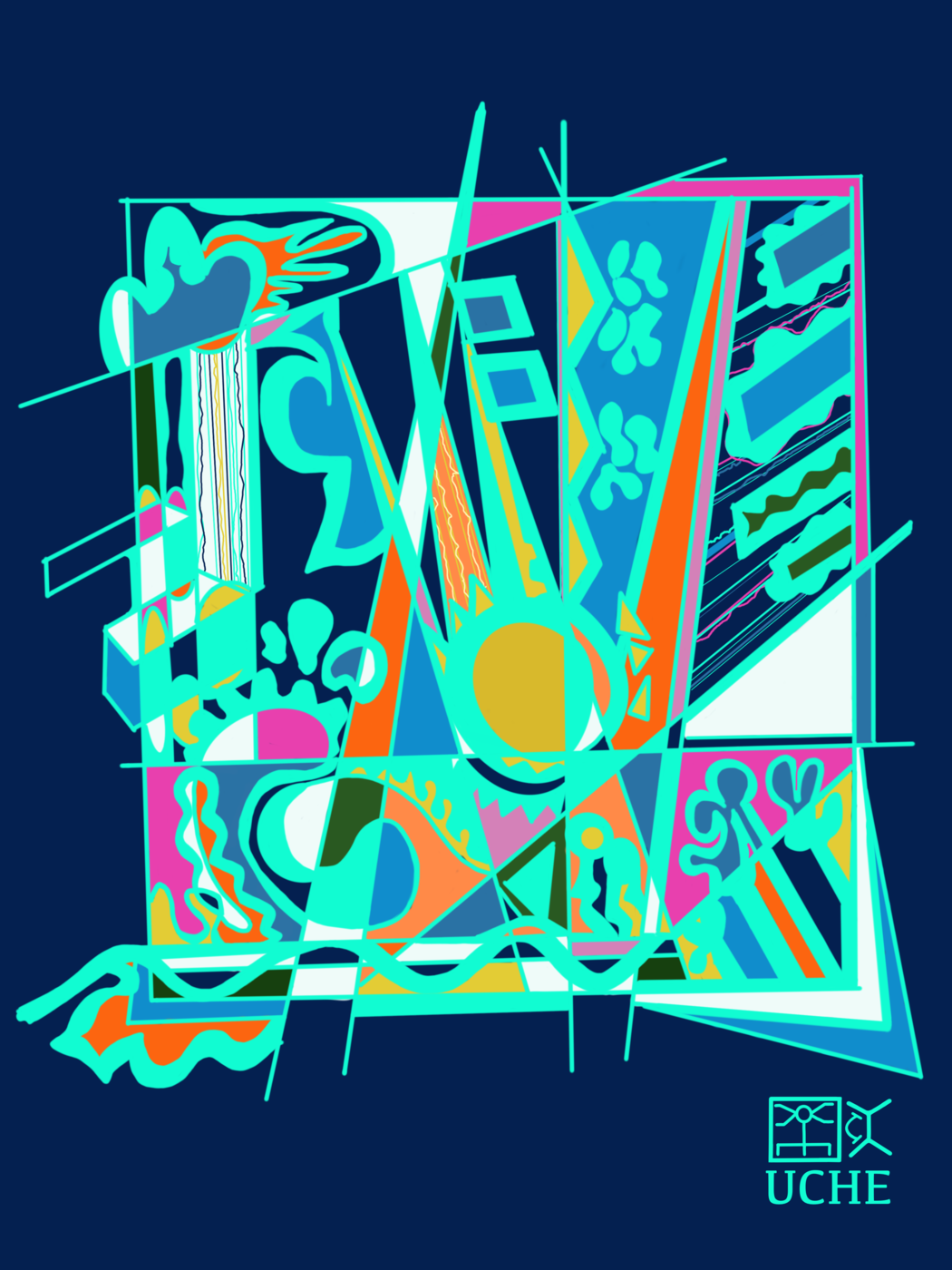 Uchenna Cecilia Dike| My X-Ray of Sunshine | 2024
Uchenna Cecilia Dike| My X-Ray of Sunshine | 2024

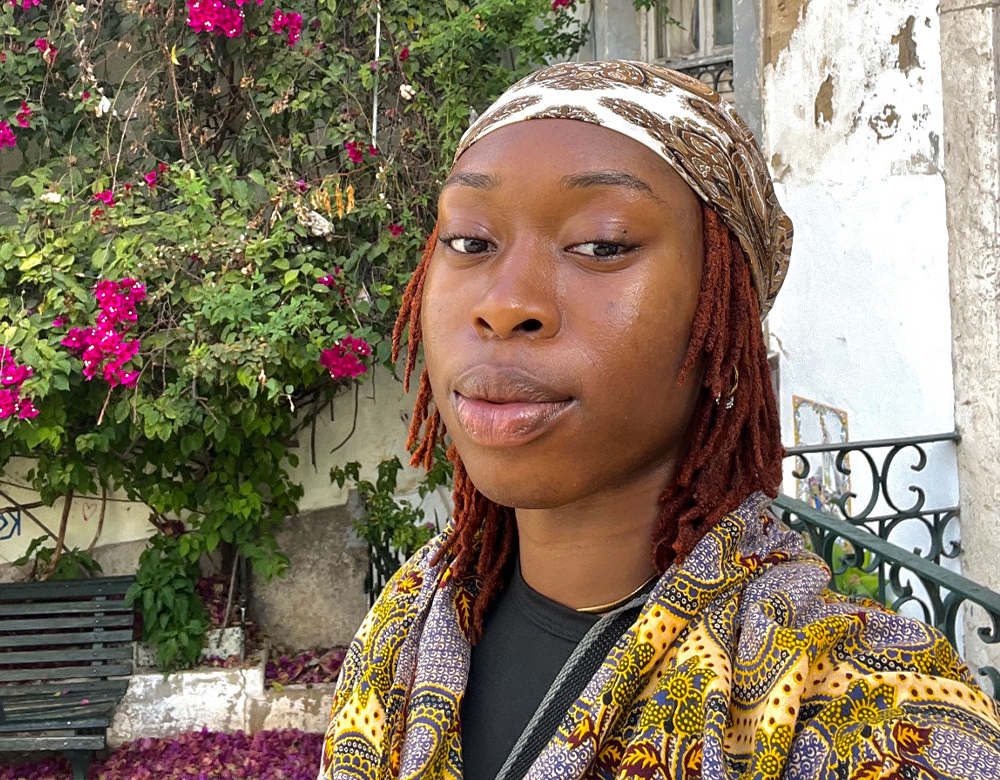
Leave a Reply